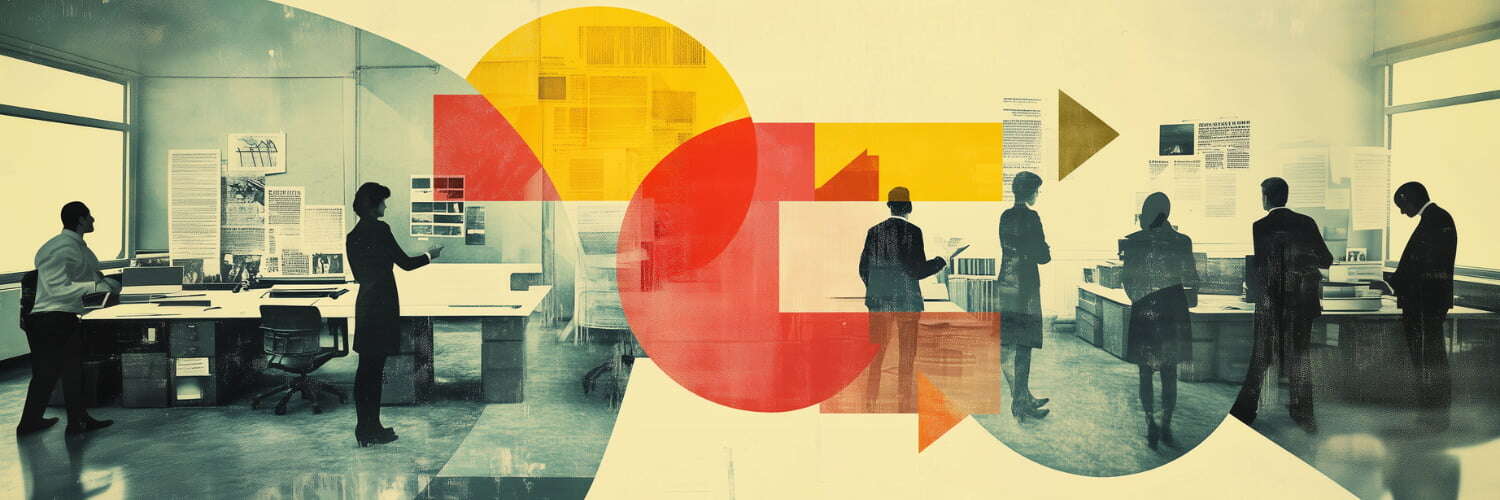Now more than ever, the challenges of managing an ever-growing remote workforce highlight the need for businesses to embrace digital. And it’s happening! The digital revolution is making its way across industries, improving business processes, cultures and customer experiences alike.
For HR departments who took the digital leap it means they’re no longer relying on the dreaded Excel spreadsheet, but what about the ones yet to do it? What does a successful HR digital transformation look like, why is it necessary, and how should they go about it? Let’s take a look.
What Is the HR Digital Transformation?
HR digital transformation is the process of adopting digital HR tools and technologies to improve operational performance. Essentially, it’s using data to guide all areas of HR, with a multifold goal in mind: to automate processes, reduce time spent on repetitive tasks, make data-driven decisions, and free up time for strategizing. And it can take various forms, depending on each business’ needs.
For example, instead of reading every resume, an Applicant Tracking System (ATS) can automatically filter out bad candidates. Or instead of walking each new hire through onboarding paperwork, an onboarding software can automate the process. Or instead of promoting employees based on instinct, a succession planning system can evaluate data on employee performance to inform decisions.
What Is the Difference Between Digitization, Digitalization, and Digital Transformation?
These three terms, often used interchangeably, are actually three steps – each leading to the next! The road to complete digital transformation HR may be long, but if you know where you stand, you can plan better.
Digitization
Digitization is a shift from manual processes to digital processes. In other words, it’s moving away from paper-based record-keeping and toward digital solutions. A business may convert its existing paper forms to electronic forms. Or it could create digital versions of previously printed shift schedules. Digitization saves money by reducing printing and distribution costs, and is the first step toward a digitized workforce.
Digitalization
Going one step further, through digitalization one becomes a digitally-managed organization. This means using digital tools for day-to-day operations and creating a culture of embracing technology. An example would be an organization that begins using AI to turn insights into outcomes. The impact of AI on HR is extremely positive if the team is able to interpret and use the data to develop new strategies.
Digital transformation
HR digital transformation is the final step and the outcome of digitization and digitalization. The main challenge is to change mindsets across the organization. For example, a fully automated recruitment process, where software makes accurate hiring predictions, must be seen by HR as something that can help, not hurt, their jobs. This HR transformation is a 4-step process:
- First, an organization must reach the entire front line through a digital channel.
- Second, time-consuming paper-based processes are dropped – and digitized.
- Third, a clear automation strategy is established for future use.
- Finally, all organizational processes get optimised with data-driven insights.
What Are the Benefits of HR Digital Transformation for Your Business?
Digital HR tech can reduce costs, improve operations, and enhance employee experiences – all increasingly important as companies compete for talent. Here are the main benefits of HR digital transformation:
Boost HR Efficiency
If your HR department is inefficient, it's not necessarily their fault. HR often struggles with decentralization, manual processes, and a lack of automated tools. But with the right technology, people and mindset, HR can automate transactional processes, and take on higher-level strategizing.
Automate HR Processes
Digital HR streamlines workflows and enhances workplace efficiency, which positively impacts the bottom line. For example, onboarding software can help new employees learn the ropes faster, and start contributing sooner. Or self-service portals can simplify document completion and management, saving time for both HR and employees.
Centralize Employee Data
Maintaining all the employee data at one centralized secure location ensures it’s accessible at any time, and eliminates clutter and paper archives. Such an employee database provides the most effective way to find the information you need, when you need it. Once the HR team has everything in one accurate system, they can make strategic decisions easier and act quicker.
Save Time and Money
Automating repetitive processes brings enormous benefits. In addition to making better use of the value of human capital, major cost savings are achieved. When employees are given the right tools to work fast and smart, they have more time to spend on tasks that actually move the business forward.
Enhanced Employee Experience
With cloud-based apps, big data, process automation, smart integrations and bots, HR can create an integrated employee experience that supports their ongoing needs. And, when they feel seen and supported, employees are more loyal, productive, and focused on meaningful tasks – ones that generate ROI.
What to Check before Starting HR Digital Transformation
The outcome of a well-executed HR digital transformation is invaluable. It’s no wonder you want to get started straight away! But first, see if your organization has…
- …more than 50 employees. This is when companies start to face administrative hurdles. A company with a large number of employees will find it difficult to manage everything on paper, so streamlining workflows suddenly becomes very important.
- …an IT department. They will lay out the transformation strategy and process, and assist with any hurdles you might encounter. You need at least one qualified IT person to help you with integration, data security, and logistics.
- … clarity over how data can help. Make sure your HR department can handle big datasets. Collecting data is pointless if you don't have the skills to interpret it or don't feel comfortable with it, because you’ll need to turn those numbers into workable strategies.
- …a human resources information system (HRIS). This is the HR software where you keep a database of your employees. It collects thousands of data points, which you will need for future software and solution implementation.
- …a clear internal goal in mind. HR digital transformation is about accomplishing clear internal goals that will lead to a specific desired outcome. For example, do you want to reduce time-to-hire by two weeks? Then you know what to look for!
What Are HR Digital Transformation Use Cases?
For Recruitment Processes
Applicant Tracking Systems (ATS)
With Applicant Tracking System (ATS) software, companies can process hundreds of applicants quickly and efficiently, eliminating unqualified candidates. ATS can also automate other HR processes, such as job posting, resume screening, interview planning, and even interview evaluation. (On this note, human bias is another reason why organizations use ATS for hiring!)
Digital Onboarding Software
Many workers have never set foot in their company's offices, having been hired after the pandemic began. But even where in-person work has continued, the onboarding process is time-consuming and sometimes inconsistent. Digital onboarding is structured and strategic, ensuring that new employees feel welcome, supported, and well-equipped to do their jobs.
Recruiting Chatbots
Recruiter chatbots help recruiters save time by screening and staging candidates. These bots engage with candidates, interpret conversational language and respond, effectively taking over tasks previously performed manually (such as scheduling interviews or collecting automated screening answers).
HR Chatbots
HR teams can now use HR chatbots to create automated responses to instantly answer the most frequently asked questions and concerns. Aside from the obvious benefits of saving time and avoiding interruptions, chatbots are a communication tool that today's workers enjoy using, and they are a convenient substitute for always dropping by the HR office.
For Improved Productivity
People Analytics
People analytics is the application of data-driven decision-making to HR processes to improve employee productivity, engagement, and performance. Organizations use people analytics to make better decisions about talent management, employee retention, succession planning, and recruitment.
Performance Management
Many companies struggle to align compensation with performance beyond leadership or sales roles. Performance management tools help HR teams build a system that rewards results. This lowers turnover and helps employees advance faster on their career paths.
Learning Management
Continuous growth is the key ingredient for success, but even large organizations still manage their learning through hard-to-use spreadsheets. Learning management software can help them keep track of candidate development, identify skills, and facilitate employee development – from training to performance review.
Compensation Management
Effective compensation management is critical to employee satisfaction. It would be demotivating to discover that your bonus has been miscalculated, for instance. Compensation management systems keep track of all aspects of compensation and facilitate this important process.
The Stages of HR Transformation
You can’t get your business through a digital transformation overnight. But, as more and more people expect to work from anywhere, the ability to compete for talent depends heavily on it. Here are the six stages of a successful HR digital transformation:
- Business as usual: This is when old solutions, such as paper records and memos, still predominate. Managers do not yet see the need for change, and HR is at a competitive disadvantage in recruiting and retaining employees.
- Present and active: Things start to change through small experiments. Management begins to see the need for digital transformation, and decides to transform existing manual HR processes and upgrade to tools and technologies fit for the digital future.
- Formalized – True transformation begins! Data influences decisions and efforts are made to find gaps and problems. Company-wide collaboration is in full swing, with representatives from all teams and executive-level supporting training and adoption of new technologies.
- Strategic – Data and feedback are collected and shared across departments. Shared insights lead to a new strategic roadmap and initial digital HR strategy. Investments are made in new people, processes, and technologies.
- Converged – A dedicated digital transformation team is formed to manage the new strategy and operations. Recruitment, onboarding, and goal journeys are redesigned to incorporate digital solutions, resulting in significant improvements in satisfaction, performance, and retention.
- Innovative and Adaptive – Digital transformation has become the new 'business as usual' and a new ecosystem has emerged. Digital drives improvements across departments, and there may even be an innovation team tracking new technological developments!
How to Get Started with HR Digital Transformation
There is no one-size-fits-all approach, of course. However, there are a number of key stages that tend to ensure a smooth shift to digital. Here’s the breakdown:
Define Your Goal
Set a clearly defined goal and then decide how you will measure success. The goal should make sense from a business perspective and have a positive financial impact, because the success of a digital transformation project is measured by its added value for the company. For example, the goal could be to reduce the cost per hire, thereby reducing the company's overall spend.
Get Everyone on Board
Inform all stakeholders, from employees to leadership, about the upcoming digital transformation – and get them excited! You will want everyone on board, and on the same page. Before you can share with them a clear overview of the goals and status, give them an idea of what the impact might be on other areas of the business.
Identify Who Will Implement the Transformation
The IT and HR departments will usually do it – working on implementation and behavioural changes across the organization, but you can also hire additional resources if needed. For example, if the goal is to use AI to gain insights about engagement and performance, hire a data scientist to analyze the data and improve business strategy.
Set a Time Frame
Processes must be given a certain amount of time to prove their value. A six-month window to implement a new tool is sufficient to determine if it’s useful to you. You should also identify which processes will be phased out if you start using a digital platform. Going through LinkedIn to find candidates may be eliminated altogether with the introduction of recruiting software.
Ask the C-Suite
It's always challenging to provide senior leadership with a case for investment, even when they’re often willing to increase spending on digital transformation. Rely on thorough research and offer good reasons for investing in new software. Look at areas that could use a digital update (recruiting, onboarding, learning and development, payroll). Prioritize based on impact and effort.
Prepare Your Team
Start on a smaller scale. It’s easier to apply the lessons learned from a pilot to a company-wide project than it is to make mistakes in a large-scale rollout! Form small teams to test the new software without disrupting traditional processes (yet) for the rest. This way, you are preparing your team for change, but keeping the impact of failure low.
Create a Culture of Digitalization
Culture is a key element of any digital transformation. A digital mindset is no longer optional, but essential in the modern workplace. To ensure a smooth digital transformation, it's important to put people first. That way, people can embrace new technology rather than fear it, making adoption easier.
New Digital Transformation and Technology Trends for HR in 2022
With a solid digital strategy and the right tools, HR departments will be equipped to stay competitive in a tight labor market, attract the right talent, and create engaging employee experiences.
Artificial Intelligence
Digital HR uses AI to pre-screen and evaluate potential candidates. Although candidates will ultimately interview in person, artificial intelligence helps the hiring process by reducing management's workload.
Cloud-Based HCM
Cloud-based HCM ensures that your company's resources, organization, and ability to share are accessible to all. Many companies are now moving to remote work, taking full advantage of cloud-based systems.
Virtual Reality
Companies that have started using virtual reality solutions for HR processes have achieved excellent results. Many have developed VR training programs that give employees a whole new experience during training.
Chatbots
Chatbots can easily clarify simple questions and gather information, and route any needs beyond their capabilities to the right representative. This helps streamline HR processes and saves everyone’s time.
So there you have it: HR digital transformation is not the daunting task it first appears to be! It is, simply put, the intelligent integration of digital technologies at all levels and across all functions in a step-by-step manner to (slowly but surely) transform an organization from the inside out. And always for the better. That's why the time for it is here and now.











